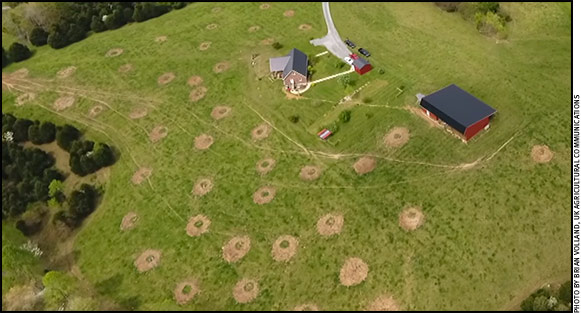
View of current bale-grazing project.
Bale-grazing Progressing in Second Year
Farmer reduces fertilizer costs by bale-grazing his cattle.
When Adair County, Ky., farmer Fred Thomas started a bale-grazing demonstration project two years ago with the University of Kentucky (UK) College of Agriculture, Food and Environment, he was looking for a way to improve the health of his cattle and his pastures. As the project moves along, Thomas continues to be encouraged by the results.
“The cattle are happier, and I am happier,” Thomas said. “They did not have to stand in mud at all this year, and it was much easier to maintain their condition through the winter. It might be premature to say, but I have more grass growing this year than I have [had] since I bought the place in 2001.”
While popular in the Northern Plains and Canada, bale-grazing is a relatively new concept to Kentucky, but it is becoming more intriguing to farmers as they look for ways to be better stewards of the environment. To bale-graze, farmers set out hay bales on their land prior to winter feeding. They use temporary fencing to control the cattle’s access to the bales. As the cattle eat the bales, farmers move the temporary fencing to give them access to more.
The movement of cattle gives farmers a better nutrient distribution across their land. This is particularly beneficial on land that has not received any other fertilization in recent years. In Thomas’s bale-grazing trials, he places the forage on higher elevations, which limits the time cattle spend near the streams and creeks in the valleys.
“Fred is going to keep more of those nutrients on his farm and keep the water that is leaving his farm cleaner,” said Jeff Lehmkuhler, UK extension beef specialist.
Thomas is working on the project with Lehmkuhler and Nick Roy, Adair County agriculture and natural resources extension agent. Thomas was a prime candidate for the project due to the topography of his land, which includes rolling hills with flat ridges, direct access to water and his need to improve his winter-feeding program and pastures. Both Lehmkuhler and Roy have helped Thomas find ways to improve the project and have helped quantify its impacts. Before the first winter, they took soil samples in fields where Thomas did and did not use bale-grazing. They tested again after winter feeding had stopped.
“At the end of the day, one of our major goals on the farm is to be profitable,” Roy said. “This past year, Fred has seen his soil-test levels for potassium go from about 75 to 200. The phosphorus was raised from 20 to 25. When we looked at those numbers, they saved Fred on average $21 per acre on his fertilizer bill this spring. Tools like bale-grazing can reduce our inputs and make us more profitable.”
The increase in nutrient distribution due to bale-grazing also helped offset fertilizer costs during 2016, as Thomas reseeded the area he bale-grazed during the winter of 2015-2016. He first seeded the area in a combination of Sudan grass and sorghum-Sudan grass, both summer annuals. Thomas let his cattle strip-graze the grasses during the summer.
“When we planted the sorghum-Sudan grass last year, we did not apply any fertilizer because none was needed,” Lehmkuhler said.
After the cattle finished grazing the summer annuals, Thomas reseeded with two novel-endophyte tall fescue varieties. He plans to graze the cattle on them later this year.
“The nice thing is, by combining bale-grazing followed by the summer annuals, we have eliminated a lot of the old KY 31 fescue here with the spray, smother, spray technique,” Lehmkuhler said. “This demonstrates another opportunity for pasture renovation while giving up minimal from a yield perspective.”
The project is still a work in progress. After the first year, Thomas, Lehmkuhler and Roy took inventory of things that were working well and aspects of the project that needed to be improved. During the winter of 2016-2017, Thomas spaced his bales farther apart in larger sections, so cattle would not do as much damage to the forage stand around the bales.
“As the season unfolded, I learned that it wasn’t so much the bale spacing as the size of the section containing the bales, regardless of bale spacing,” Thomas said.
This summer, Roy and Thomas are measuring the amount of forage growth in the fields that were bale-grazed this past winter compared to fields he hasn’t bale-grazed. Thomas plans to continue the project for at least another year. This fall, he will do another experiment to determine if it causes less damage to the existing forage stand to have larger sections with bales spaced closer together or spread throughout the field.
“I can’t see going back to what I used to do, which was every three or four days take three or four hay rolls to the cattle through the mud, snow and rain and try to find a new area to set it,” Thomas said. “I’m going to try it again next year because I like what I see so far.”

Editor’s Note: Katie Pratt is an agricultural communications specialist for the University of Kentucky College of Agriculture, Food and Environment.






